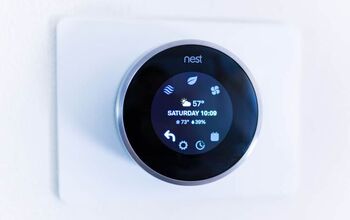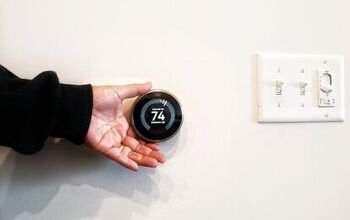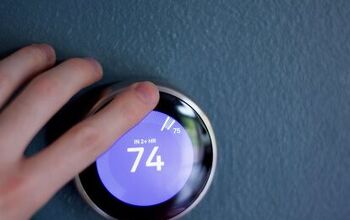How To Set A Nest Thermostat To Hold The Temperature

Smart technology is more common in homes as it aids homeowners in their everyday lives. These include smart security systems, Google Home, and the Amazon Alexa, which serve many functions. Even traditional thermostats have smart technology alternatives.
The Nest Thermostat is a popular choice for homeowners looking for more dynamic control over the temperature in their home. The Nest is convenient and easy to use. Depending on the model, it is programmed with various smart features designed to save you money on your energy bill.
To set the Nest thermostat to hold the temperature, you can do it through a phone app or from the thermostat. Following the prompts on the menu screen will guide the user through the steps to the hold option. Hitting the start button will hold the temperature, or pressing hold from the menu screen will allow the same performance.
Do You Need Your Thermostat Repaired or Reprogrammed?
Get free, zero-commitment quotes from pro contractors near you.

Information on the Nest Thermostat
The Nest Thermostat is a smart thermostat sold by Google that controls the temperature in your home. The Nest can be controlled through the app on your phone or the thermostat directly. The app is called “Nest” and be obtained for free on your smartphone’s app store.
The Nest has multiple temperature options. You can set a Schedule on your Nest, or it can adjust the temperature for you based on your activity. Nests can also be purchased with add-ons such as temperature sensors.
Overall, the Nest has a simple to use design. In addition to fixing the temperature on your app, you can rotate the circular Nest to the temperature you desire.
How to Hold the Nest Temperature
There are two ways to set a temperature hold on the Nest. You can use the app or program the thermostat directly. Listed are steps on starting the hold process and ending it for the app and the thermostat screen.
Steps In Starting the Temperature Hold In the App
An app is installed on Android and iPhones to work the Nest Thermostat. If you have an Android, you can get it from Google Playstore. For iPhones, you can get it through Apple.
Step 1: Go to the Home Screen on the App
On your smartphone home screen, go to the thermostat app and select it.
Step 2: Click the Hold Option
After clicking the thermostat app, click the Hold option. It will ask you to hold the current temperature or select a different temperature.
Step 3: Choose the Temperature Desired to Hold
When you decide the temperature you want to hold, select it, and the Nest will adjust to it.
Step 4: Check the Mode of the Thermostat
Make sure to check the mode is ON, on the thermostat. You will have to choose one of the three options, heating, cooling, or heating/cooling.
Step 5: Start the Hold Feature
To wrap it up, you will choose the length of the hold then select “start.” This will begin the hold process.
“Hold” Options of the Nest
Selecting Hold from the Thermostat’s Screen
- Select Menu.
- Select Hold.
- Choose the Temperature.
- Select the time frame in the Temperature option.
How to End the Temperature Hold
Ending the hold is simple from the app and the thermostat screen. If you wish to adjust the temperature of your hold, you will have to end the current one and start a new hold.
Ending the Hold from the App
Listed is the order to end the hold from your smartphone.
- Go to the phone’s apps.
- Find the Thermostat App and select it.
- Click the “Hold” option.
- Tap “End Hold.”
Ending the Hold from the Thermostat Screen
Listed is the order to end the hold from the thermostat screen.
- Go to the Menu option.
- Select “Hold.”
- Select “Stop.”
Why Should I Choose the Nest?
Statements out of the United States Department of Energy say that heating and cooling systems make up roughly 50 percent of energy consumption. Standard thermostats can sense the room temperature and heat or cool it based on the settings.
If the thermostat is on 70 degrees, but the room falls below that, the thermostat turns the heat on. The heat and the blower return the room to the proper temperature. The Nest aims to improve this traditional technology. The Nest learns your behavior to adjust the temperature for you.
Over time, you will no longer need to manually set the temperature or constantly adjust it to your liking. The Nest saves money by limiting the energy your system uses when you are not around.
Presence sensing uses a variety of methods to determine your activity and adjust the temperature accordingly. This mode uses sensors and your phone location to alternate between Home and Away modes. You can input the temperature settings for these modes to your preference.
Heating and cooling an empty house wastes money but can still run just enough to keep temperatures in check. So, the Nest’s Eco Temperature technology saves energy when people are not home.
Choosing the Right Nest Model
Every model is different, but you can choose the right Nest thermostat for your needs. They work for the homebody or those who are away from home often.
Not every model has the hold feature. It is recommended that you understand the different features before you purchase one for your home. These models include the Nest Thermostat, the Nest Thermostat E, and the Nest Learning Thermostat.
The latter two can learn your behavior over time and develop a personalized temperature schedule that best suits your needs. The regular Nest Thermostat will not remember your activity, but it does have Eco Temperature technology. It also has a Savings Finder, which will provide you with suggestions to save money on your bills.
The products advertise that you will save 10 to 12 percent on heating bills on average and 15 percent on cooling bills.
Setting Up the Nest
The Nest requires an electrical system with low voltage. If you are replacing your current thermostat, look at the back of it. It should display how many volts the thermostat is.
A value between 100 and 250 VAC, which stands for Voltage Alternating Current, is a high voltage system. If you find that you have a high voltage system, it is recommended to call an electrician or other professional for install. They can assist in converting the high voltage system to a low voltage system that will work with your Nest thermostat.
Google also offers professional installation for your Nest at the time of purchase, for an extra cost. Despite this, the Nest is easy to install if your system is already compatible.
Google claims that installation should take 30 minutes or less. The Nest comes with instructions, but Google support also provides helpful five-minute installation videos for beginners.
Google also sells a Nest Trim Kit designed to create a sleek look and hide any imperfections. During the process of installation, cracks, holes, or scratches may have formed on the wall during installation.
When Should You Operate the Hold Temperature?
The nest has options for automatic or scheduled temperature changes. For instance, you may wish to lower the temperature at night when you are less active. You may want to program the nest to raise the temperature anytime it falls below 70 degrees.
Sometimes you wish to override those options and leave the temperature at a constant value. This is where “holding” the temperature comes in.
These smart devices are becoming more like family. Even though the Nest learns your behavior and adjusts the temperature accordingly, the “hold” setting is a helpful feature. It can spare the life of the thermostat from constantly raising and lowering the temperature, which is not good for the unit.
It is particularly beneficial when you leave your house for an extended period. This comes in handy when you leave for the day or work and more extended periods. When you are on vacation, the hold option will spare the pocketbook when the electric bill arrives.
Do You Need Your Thermostat Repaired or Reprogrammed?
Get free, zero-commitment quotes from pro contractors near you.

Related Questions
Are there other smart thermostat options?
Yes. Though the Nest Thermostat is one of the most popular options on the market, there are many other smart thermostats. Ecobee and Honeywell sell several models that also have compatibility with smart home devices such as Google Assistant and the Amazon Alexa.
What is the cost of the Nest?
The Nest Thermostat will run you $129.99, while a Nest Learning Thermostat costs $249.00. Nests can be purchased in bundles for a discount. Google offers the optional addition of professional installation for $99.Although the Nest does utilize your wi-fi network to run its smart functions, there is no monthly subscription fee. Nests can be purchased through Google directly or at retailers such as Lowes, Best Buy, and Amazon.
What else can the Nest do?
The Nest has other useful settings, including reminders to change your air filters and the Home Report, which tells you how much electricity you are saving. Additionally, the Nest is compatible with your Google Assistant, so you can set the temperature using voice control.

We are a team of passionate homeowners, home improvement pros, and DIY enthusiasts who enjoy sharing home improvement, housekeeping, decorating, and more with other homeowners! Whether you're looking for a step-by-step guide on fixing an appliance or the cost of installing a fence, we've here to help.
More by Upgraded Home Team


















![10 Most Dangerous Neighborhoods in Baltimore [Updated]](https://cdn-fastly.upgradedhome.com/media/2023/07/31/9075655/10-most-dangerous-neighborhoods-in-baltimore-updated.jpg?size=350x220)








